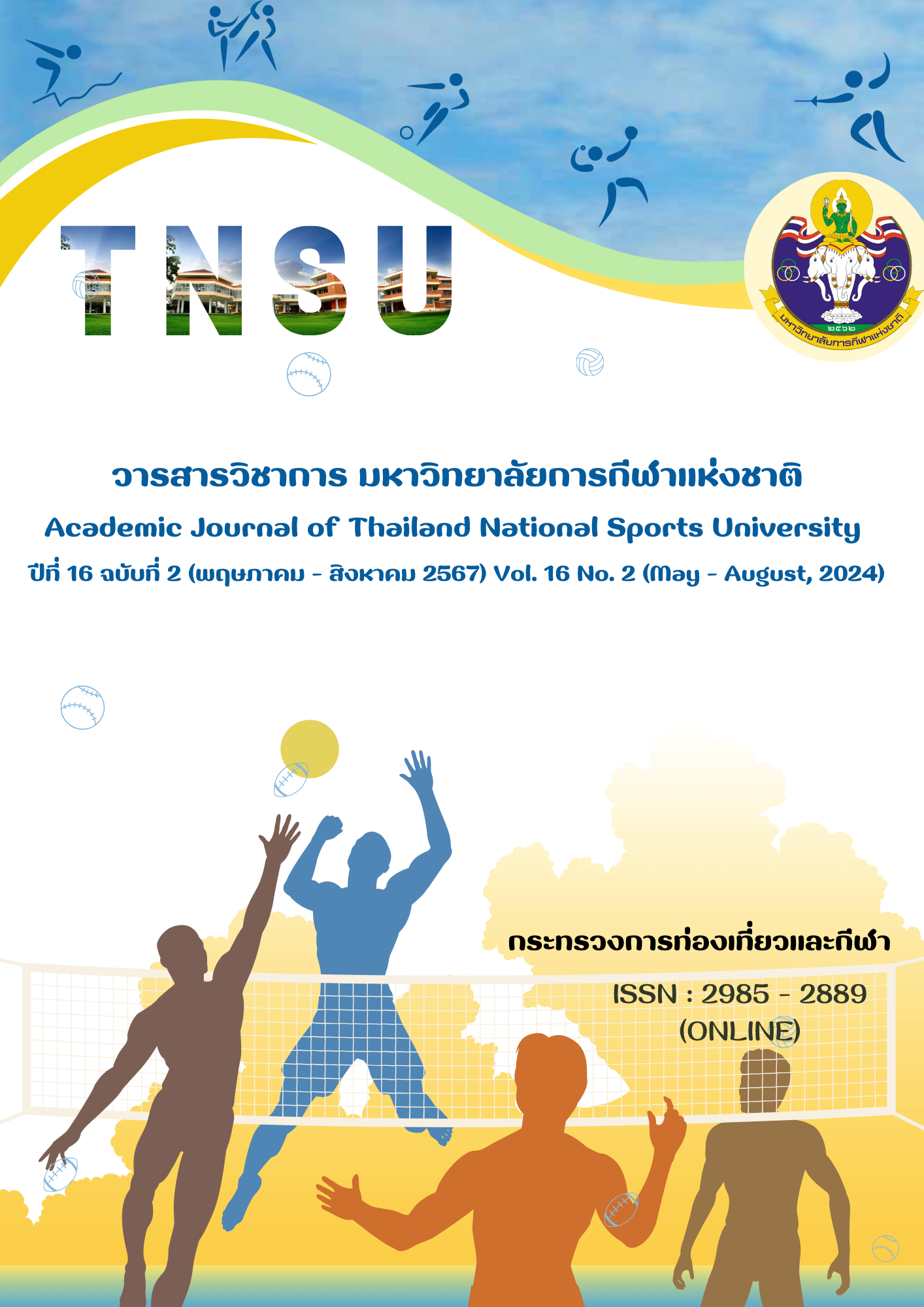ผลของการฝึกออกกำลังกายต่อเนื่องความเข้มข้นสูงที่มีต่อการเปลี่ยนแปลง ทางสรีรวิทยาในวัยรุ่น
Main Article Content
บทคัดย่อ
การออกกำลังกายแบบแอโรบิกได้แสดงให้เห็นถึงประโยชน์ต่อร่างกาย นอกเหนือจากประโยชน์แล้ว ความเข้มข้นของการออกกำลังกายมีบทบาทสำคัญในการกระตุ้นการพัฒนาสมรรถภาพทางกาย ปัจจุบัน การฝึกออกกำลังกายต่อเนื่องความเข้มข้นสูงเป็นวิธีการออกกำลังกายแบบแอโรบิกที่รู้จักกันดี ความเข้มข้นของการออกกำลังกายแบบแอโรบิกสามารถส่งผลระยะยาวต่อการพัฒนาสมรรถภาพทางกายได้ (Kraus et al., 2002) การศึกษานี้มีวัตถุประสงค์เพื่อศึกษาผลการเปลี่ยนแปลงทางสรีรวิทยาหลังการฝึกออกกำลังกายต่อเนื่องความเข้มข้นสูง ผู้เข้าร่วมการศึกษาเป็นนักศึกษามหาวิทยาลัยนครพนม จำนวน 30 คน เพศชาย 14 คน และเพศหญิง 16 คน เป็นผู้ทีมีสุขภาพดี มีอายุเฉลี่ย 18.57±.50 ปี มีส่วนสูงเฉลี่ย 163.88±6.44 เซนติเมตร และมีน้ำหนักเฉลี่ย 54.79 ± 4.24 กิโลกรัม เครื่องมือที่ใช้ในการวิจัย คือ โปรแกรมการฝึกออกกำลังกายต่อเนื่องความเข้มข้นสูง ผู้เข้าร่วมการศึกษาทำการฝึกออกกำลังกายทุกวันๆ ละ 1 ชั่วโมง 30 นาที เป็นเวลา 8 สัปดาห์ และแบบทดสอบสมรรถภาพทางกายที่เกี่ยวข้องกับสุขภาพ ทำการวัดน้ำหนักตัว ชีพจรขณะพัก ดัชนีมวลกาย ความแข็งแรงกล้ามเนื้อเหยียดแขนและขา สมรรถภาพทางการใช้ออกซิเจนก่อนและหลังการฝึกออกกำลังกาย สถิติที่ใช้ทำการวิเคราะห์ข้อมูล คือ ค่าเฉลี่ยและส่วนเบี่ยงเบนมาตรฐาน และสถิติ paired - sample t - test วิเคราะห์ความแตกต่างหลังการฝึกออกกำลังกาย 8 สัปดาห์ ทดสอบความมีนัยสำคัญทางสถิติที่ระดับ .05 ผลการศึกษาพบว่า ตัวแปรน้ำหนักร่างกาย ดัชนีมวลกาย ชีพจรขณะพัก ความแข็งแรงกล้ามเนื้อขา และสมรรถภาพการใช้ออกซิเจนมีความแตกต่างอย่างมีนัยสำคัญหลังการฝึกออกกำลังกายต่อเนื่องความเข้มข้นสูงเป็นเวลา 8 สัปดาห์ ผลลัพธ์เหล่านี้ชี้ให้เห็นว่า การฝึกออกกำลังกายต่อเนื่องด้วยความเข้มข้นสูงนำไปสู่การกระตุ้นอัตราการเผาผลาญ ทำให้มีการเผาผลาญคาร์โบไฮเดรตและไขมันเพิ่มขึ้นนำไปสู่การลดน้ำหนักและพัฒนาสมรรถภาพทางกายของวัยรุ่นได้ ดังนั้น การกำหนดโปรแกรมการออกกำลังกายแบบแอโรบิกควรคำนึงถึงปริมาณและความหนักให้สอดคล้องกับวัตถุประสงค์ของการออกกำลังกาย
Article Details

อนุญาตภายใต้เงื่อนไข Creative Commons Attribution-NonCommercial-NoDerivatives 4.0 International License.
บทความที่ได้รับการตีพิมพ์เป็นลิขสิทธิ์ของวารสารวิชาการ มหาวิทยาลัยการกีฬาแห่งชาติ ข้อความที่ปรากฏในบทความแต่ละเรื่องในวารสารวิชาการเล่มนี้ เป็นความคิดเห็นส่วนตัวของผู้เขียนแต่ละท่านไม่เกี่ยวข้องกับวารสารวิชาการมหาวิทยาลัยการกีฬาแห่งชาติ แต่อย่างใด ความรับผิดชอบองค์ประกอบทั้งหมดของบทความแต่ละเรื่องเป็นของผู้เขียนแต่ละท่าน หากมีความผิดพลาดใดๆ ผู้เขียนแต่ละท่านจะรับผิดชอบบทความของตนเองแต่ผู้เดียว
เอกสารอ้างอิง
Abernethy, B., Hanrahan, S. J., Kippers, V., MacKinnon, L. T., & Pandy, M. G. (2005). The biophysical foundations of human movement (2nd ed.). Champaign, IL: Human Kinetics.
Andersen L. B., Riddoch C., Kriemler S., Hills A. P. & Hills A. (2011). Physical activity and cardiovascular risk factors in children. British Journal Sports Medicine, 45(11), 871 - 876.
Blair, S. N., Kohl, H. W., Barlow, C. E., Paffenbarger, R. S., Gibbons, L. W., & Macera, C. A. (1995). Changes in physical fitness and all - cause mortality: A prospective study of healthy and unhealthy men. Jama, 273(14), 1093 - 1098.
Biddle, S. J., Gorely, T., & Stensel, D. J. (2004). Health - enhancing physical activity and sedentary behaviour in children and adolescents. Journal of sports sciences, 22(8), 679 - 701.
Bompa, T. O., & Haff, G. G. (2009). Periodization theory and methodology of training (5th ed.). Champaign, IL: Human Kinetics.
Chusak Vejchaphaet, & Kanya Palawiwat. (1993). Physiology of exercise (4th ed.). Bangkok: Thunkamol Press.
Delbono, O. (2003). Neural control of aging skeletal muscle. Aging cell, 2(1), 21 – 29.
Després, J. P., & Lamarche, B. (1994). Low - intensity endurance exercise training, plasma lipoproteins and the risk of coronary heart disease. Journal of internal medicine, 236(1), 7 - 22.
Fiatarone, M. A., Marks, E. C., Ryan, N. D., Meredith, C. N., Lipsitz, L. A., & Evans, W. J. (1990). High - intensity strength training in nonagenarians’ effects on skeletal muscle. Journal of the American Medical Association, 263(22), 3029 - 3034.
Hoeger, W. K., & Hoeger, S. A. (2010). Principles and labs for physical fitness (7th ed.). Belmont Wadsworth, Cengage Learning.
Kraus, W. E., Houmard, J. A., Duscha, B. D., Knetzger, K. J., Wharton, M. B., McCartney, J. S., Bales, C. W., Henes, S., Samsa, G. P., Otvos, J. D., Kulkarni, K. R., & Slentz, C. A. (2002). Effects of the amount and intensity of exercise on plasma lipoproteins. New England Journal of Medicine, 347(19), 1483 - 1492.
Lora - Pozo, I., Lucena - Anton, D., Salazar, A., Galan - Mercant, A., & Moral - Munoz, A. (2019). Benefits of the high - intensity interval training versus moderate, low - intensity or control for type 2 diabetes: Systematic review and meta - analysis. International Journal of Environmental Research and Public Health, 16(22).
Mbouh, S., Nkouta, L. R. E., Minye, E. E., Nguimgou, N. T., Kalniga, P. D., & Demba, P. B. A. (2022). Biological follow - up and evaluation of the effects of a training program based on specific exercises on the leucocyte count of a group of Cameroonian handballers. International Journal of Sports Science and Physical Education, 7(3), 74 - 79.
McGill, Jr. H. C., McMahan, C. A., Herderick, E. E., Malcom, G. T., Tracy, R. E., & Strong, J. P. (2000). Origin of atherosclerosis in childhood and adolescence. American Journal of Clinical Nutrition, 72(suppl.), 1307S – 1315S.
Ramos, A. K., Calafat, A. P., Martinez, P. J., & Fages, C. A. (2022). Effects of high - intensity interval training on patients with 2 diabetes mellitus: A narrative review. Scientific Journal of Sport and performance, 2(1), 36 - 43.
Ramsbottom, R., Brewer, J., & Williams, C. (1988). A progressive shuttle run test to estimate maximal oxygen uptake. British Journal of Sports Medicine, 22(4), 141 – 144. doi: 10.1136/bjsm.22.4.141.
Resaland, G. K., Anderssen, S. A., Holme, I. M., Mamen, A., & Andersen, L. B. (2010). Effects of a 2-year school - based daily physical activity intervention on cardiovascular disease risk factors: the Sogndal school-school-intervention study. Scandinavian Journal of Medicine & Science in Sports, 21(6), e122 - e131.
Ruslan, S., Ilias, N. F., Azidin, R. M. F. R., Omar, M., Ghani, R. A., & Ismail, H. (2022). Effect of high intensity interval training and moderate intensity continuous training on blood pressure and blood glucose among T2DM patients. Journal of Physical Education and Sport, 22(10), 2334 - 2339.
Strong, W. B., Malina, R. M., Blimkie, C. J. R., Daniels, S. T., Dishman, R. K., Gutin, B., Hergenroeder, A. C., Must, A., Nixon, P. A., Pivarnik, J. M., Rowland, T., Trost, S., & Trudeau, F. (2005). Evidence based physical activity for school - age youth. The Journal of Pediatrics, 146(6), 732 - 737.
Verdijk, L. B., Gleeson, B. G., Jonkers, R. A. M., Meijer, K., Savelberg, H. H. C. M., Dendale, P., & Van Loom, L. J. C. (2009). Skeletal muscle hypertrophy following resistance training is accompanied by a fiber type - specific increase in satellite cell content in elderly men. Journal of Gerontology, 64A(3), 332 - 339.
Whelton, S. P., Chin, A., Xin, X., & He, J. (2002). Effect of aerobic exercise on blood pressure: A meta - analysis of randomized, controlled trials. Annals of internal medicine, 136(7), 493 - 503.
Williams, P. T., Krauss, R. M., Vranizan, K. M., Albers, J. J., Terry, R. B., & Wood, P. D. (1989). Effects of exercise - induced weight loss on low density lipoprotein subfractions in healthy men. Arteriosclerosis: An Official Journal of the American Heart Association, 9(5), 623 - 632.
Zivkovic, V., Gontarev, S., Telai, B., Kalac, R., & Velickovska, L. A. (2017). The association between high blood pressure, physical fitness and fatness in adolescents. Nutrición Hospitalaria, 34(1), 35 - 40.


